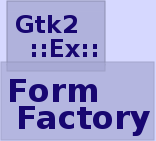NAME
Gtk2::Ex::FormFactory::Layout - Do layout in a FormFactory framework
SYNOPSIS
package My::Layout; use base qw/Gtk2::Ex::FormFactory::Layout/; sub build_form { ... } sub add_widget_to_form { ... } ... package main; $ff = Gtk2::Ex::FormFactory->new ( layouter => My::Layout->new(), ... );
DESCRIPTION
This class implements the layout of Containers and their Widgets in a Gtk2::Ex::FormFactory framework. "Layout" means, how are the widgets aligned to each other, how much space is between them, how are titles rendered, how labels, etc.
The idea behind Gtk2::Ex::FormFactory::Layout is to have a unique point in a GUI application which actually implements these things. The advantage of this approach is obvious: the implementation is very generic and if you want to change layout things you subclass from Gtk2::Ex::FormFactory::Layout and implement your changes there, and not at hundreds of spots distributed over the source code of your application.
The natural result: a consistent looking GUI.
SUBCLASSING
As described above implementing your own layout module starts with subclassing from Gtk2::Ex::FormFactory::Layout. To use your layout implementation set an object of your class as layouter in your Gtk2::Ex::FormFactory objects.
Gtk2::Ex::FormFactory::Layout mainly defines two sorts of methods.
BUILD METHODS
The names of the methods are derived from the Widget's short names (which can be retrieved with $widget->get_type), with a prepended build_, e.g.:
build_form ( ... ) build_label ( ... ) build_table ( ... )
The method prototype looks like this:
- $layout->build_TYPE ($widget)
-
$widget is the actual Gtk2::Ex::FormFactory::Widget, e.g. Gtk2::Ex::FormFactory::Form for build_form($form).
The build_TYPE method actually creates the necessary Gtk2 widgets, e.g. a Gtk2::Table for a Gtk2::Ex::FormFactory::Form and adds these to the FormFactory's widget instance using the set_gtk_widget() and set_gtk_parent_widget() methods of Gtk2::Ex::FormFactory::Widget.
Call $widget->set_gtk_widget($gtk_widget) for the primary Gtk2 widget which directly displays the value in question, e.g. a Gtk2::Entry if you're dealing with a Gtk2::Ex::FormFactory::Entry.
If you like to do more layout things which require to add the primary Gtk2 widget to a container, e.g. a Gtk2::Frame, you must call $widget->set_gtk_parent_widget($gtk_parent_widget) with the most top level container widget.
Note: the implemenations of all the FormFactory's widgets expect a specific gtk_widget to be set. If you like to change the primary Gtk widget you need to create your own Gtk2::Ex::FormFactory::Widget for this, because the default implemention most probably won't work with a another Gtk2::Widget.
ADD...TO... METHODS
The second type of methods are so called add-to methods, which place a widget inside a container. The prototye is as follows:
- $layout->add_TYPE_to_TYPE ($widget, $container)
-
$widget is the actual Gtk2::Ex::FormFactory::Widget, e.g. Gtk2::Ex::FormFactory::Form for build_form($form).
Examples:
add_form_to_window ( ... ) add_table_to_form ( ... )
This way you can adjust layout at a very detailed level, but you need not. E.g. the implementation of these methods is most likely the same:
add_entry_to_form ( ... ) add_popup_to_form ( ... )
because the implemenation mainly depends on the form (the container widget) and not on the widget which is added to the form.
That's why Gtk2::Ex::FormFactory::Layout knows a default mechanism: if no add-to method is found for a specific widget/container pair, a generic default implementation is used instead. These are named as follows:
add_widget_to_window ( ... ) add_widget_to_form ( ... ) add_widget_to_table ( ... ) add_widget_to_vbox ( ... ) ...
For a new Container you just need to implement the generic add_widget_to_TYPE method, and everything will work. If you want to slightly modify the implementation for specific child widgets, you implement only the methods for these and you're done.
For a example for such a specific add-to message refer to add_menu_to_window() which attaches the menu without any space around it. The default of a Gtk2::Ex::FormFactory::Window is to have some spacing, which looks ugly around a menu.
OBJECT HIERARCHY
Gtk2::Ex::FormFactory::Layout
ATTRIBUTES
This class has not attributes.
AUTHORS
Jörn Reder <joern at zyn dot de>
COPYRIGHT AND LICENSE
Copyright 2004-2006 by Jörn Reder.
This library is free software; you can redistribute it and/or modify it under the terms of the GNU Library General Public License as published by the Free Software Foundation; either version 2.1 of the License, or (at your option) any later version.
This library is distributed in the hope that it will be useful, but WITHOUT ANY WARRANTY; without even the implied warranty of MERCHANTABILITY or FITNESS FOR A PARTICULAR PURPOSE. See the GNU Library General Public License for more details.
You should have received a copy of the GNU Library General Public License along with this library; if not, write to the Free Software Foundation, Inc., 59 Temple Place - Suite 330, Boston, MA 02111-1307 USA.
